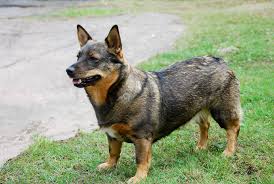Charming, intelligent, and a dash of ancient Viking legacy—meet the Swedish Vallhund. With their fox-like face and Corgi-esque body, these spirited little herders pack a whole lot of personality into a compact frame. If you're seeking a loyal buddy with a rich history and boundless energy, you’re about to fall head over paws for this breed.
Swedish Vallhund Breed Facts
- Origin: Sweden, dating back to the 8th or 9th century
- Group: Herding
- Size: 11.5 to 13.75 inches tall, 20–35 lbs
- Coat: Medium length, dense double coat
- Lifespan: 12–15 years
Fun fact: The Swedish Vallhund is believed to have been a companion to Vikings. That explains their confident, no-nonsense attitude!
Swedish Vallhund Temperament and Behavior
Energetic, brave, and incredibly loyal, Vallhunds are natural problem-solvers. They form tight bonds with their families and have a strong desire to be involved in everything you do. Expect a dog that follows you from room to room and lets out a bark if something’s amiss—they're excellent watchdogs.
They do best with owners who are consistent and positive in their training style. Vallhunds are sensitive but eager to please, making them a joy to train when you engage their sharp minds.
Swedish Vallhund Herding Instincts
This breed lives and breathes herding. Their instincts are strong—they might try to herd kids, other dogs, or even fast-moving objects like bikes. Proper training helps channel these instincts into fun games or structured activities like agility or herding trials.
Training a Swedish Vallhund Puppy
Early socialization is key. Introduce your puppy to varied sights, sounds, and experiences while rewarding calm behavior. Positive reinforcement works wonders. Vallhunds love a mental challenge, so puzzle toys, scent work, and trick training will keep them engaged and happy.
- Start basic commands at 8 weeks
- Crate training helps with boundaries
- Prevent nipping/herding behaviors early
- Enroll in puppy classes for confidence building
Swedish Vallhund Exercise Needs
These dogs are high-energy dynamos! Plan for at least 60–90 minutes of activity a day. They thrive with structured play, walks, hikes, and brain games. Without enough stimulation, they can become vocal or mischievous.
“Our Vallhund, Freyja, loves hiking and scent games. She'll outlast us all on the trails, but is happy to snuggle afterward.” — a proud Vallhund parent
Swedish Vallhund Grooming and Care
- Brushing: 2–3 times a week, daily during shedding season
- Bathing: Only when necessary
- Nail trimming: Monthly
- Ear care: Weekly checks
- Dental care: Brush teeth 2–3 times a week
Despite their double coat, Vallhunds don’t need trimming. Their fur is self-cleaning and water-resistant, just like a good Viking should have!
Swedish Vallhund Health Issues
Generally healthy, but keep an eye out for:
- Progressive Retinal Atrophy (PRA)
- Hip dysplasia
- Obesity from lack of exercise
Reputable breeders screen for common issues. Regular vet checkups and a balanced diet go a long way in maintaining their health.
Swedish Vallhund Lifespan and Care
With proper care, your Vallhund can live a vibrant life of 12 to 15 years. Mental stimulation, consistent training, social interaction, and high-quality nutrition are all pillars of their well-being. Don’t forget lots of love—they’re Velcro dogs who thrive with affection.
Swedish Vallhund vs Corgi: What’s the Difference?
At first glance, they look similar—but there are key differences:
- Tail: Vallhunds can be born with tails of varying lengths; Corgis usually have docked or full tails
- Body: Vallhunds are leaner and more agile
- Temperament: Vallhunds tend to be more reserved with strangers and bark less
- Origin: Swedish Vallhunds hail from Sweden, Corgis from Wales
Swedish Vallhund with Children
They’re great with respectful children, especially when raised together. Teach kids how to properly interact with dogs—no ear pulling or climbing. Vallhunds are affectionate but may try to herd running toddlers, so supervision is key.
Summary: Is the Swedish Vallhund Right for You?
If you’re active, love training, and want a bright, loyal dog with a history as rich as its personality, the Swedish Vallhund may be your perfect companion. With their intelligence and charm, they’re true treasures of the canine world.
Frequently Asked Questions (FAQs)
1. What is the temperament of a Swedish Vallhund?
2. How much exercise does a Swedish Vallhund need?
3. Are Swedish Vallhunds good with children?
4. What are common Swedish Vallhund health issues?
5. How do Swedish Vallhunds differ from Corgis?
6. What grooming does a Swedish Vallhund require?

About SniffnTail
SniffnTail is your go-to destination for everything pets. From helpful advice, tips, and insights to thoughtfully selected products and resources, we’re here to support pet owners at every stage of their journey. Whether you're caring for a playful pup, a wise old cat, or anything in between, SniffnTail offers tools and knowledge to make pet parenting easier and more joyful.
Related Articles
 Dog Breeds • 7 minutes
Dog Breeds • 7 minutesDachshund Dog Breed Guide: Personality, Care & Living Tips
Discover the unique personality traits, training needs, and care tips for Dachshunds. Learn all about their temperament, grooming needs, lifespan, and apartment suitability in this expert breed guide.
 Dog Breeds • 5 mins Read
Dog Breeds • 5 mins ReadDoberman Pinscher Care & Behavior Guide
The Doberman Pinscher is a sleek, powerful, and intelligent working breed originally developed in Germany. Renowned for loyalty, protectiveness, and trainability, Dobermans are often used in security, police, and military roles, but also make loyal and affectionate family companions.
 Dog Breeds • 12-15 minutes
Dog Breeds • 12-15 minutesWest Highland White Terrier (Westie): Your Complete Care & Breed Guide
Unlock expert Westie dog facts, essential grooming secrets, effective training tips, health insights, and comprehensive puppy care. This ultimate West Highland White Terrier guide ensures every pet parent raises a happy, healthy companion. Get your Westie answers here!

